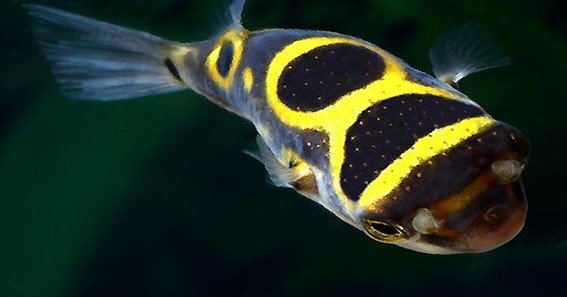Dichotomyctere (Formerly a part of Tetraodon) is a rather small genus of mostly similarly-sized pufferfish, containing three of the most popular aquarium puffers in the world: Dichotomyctere nigroviridis, the green-spotted pufferfish, Dichotomyctere ocellatus, the figure eight pufferfish, and Dichotomyctere fluviatillis, the Ceylon pufferfish. This thread is a look into the biology and care of those three species, as well as the other 3 known Dichotomyctere species.
Green-Spotted/Leopard Pufferfish
Dichotomyctere nigroviridis
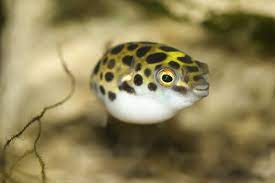
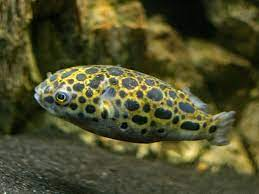
Average size: 5.5"-6.5"
Care: Intermediate
pH: 7.5-8.5
Salinity: 1.010-1.025
Minimum tank size: 40 gallons/Individual
Temperature: 75-80° F
Diet: Frozen and live foods such as snails, feeder guppies, worms, shrimp, frozen fish, snails, mussels, etc. Like most puffers, it is mandatory to feed this species hard foods in order to trim its teeth.
Natural range: Costal brackish waters, as well as freshwater lakes, streams, and rivers in Asian countries such as India, Sri Lanka, Myanmar, Thailand, Cambodia, Vietnam, Malaysia, Indonesia and the Philippines.
Additional info: Perhaps the most common aquarium pufferfish.
Figure Eight/Eyespot Pufferfish
Dichotomyctere ocellatus
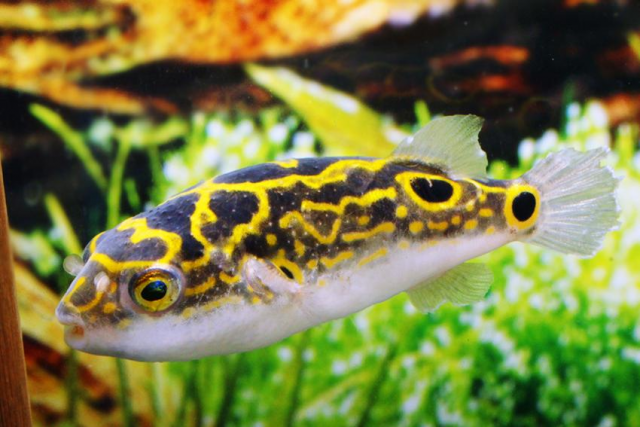
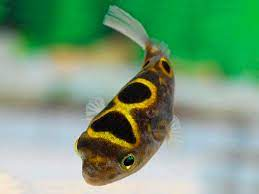
Average size: 3"-4"
Care: Intermediate
pH: 7.5-8.0
Salinity: 1.005-1.008
Minimum tank size: 20 gallons/Individual
Temperature: 75-80° F
Diet: Frozen and live foods such as snails, feeder guppies, worms, shrimp, frozen fish, snails, mussels, etc. Like most puffers, it is mandatory to feed this species hard foods in order to trim its teeth.
Natural range: Freshwater rivers and coasts, also commonly found in brackish water within Asian countries such as Cambodia, Malaysia, and Indonesia.
Additional info: Nicknamed the "eyespot pufferfish" due to their spots, which are believed to serve as "false eyes," a defense mechanism against potential predators.
Ceylon/Green Pufferfish
Dichotomyctere fluviatillis
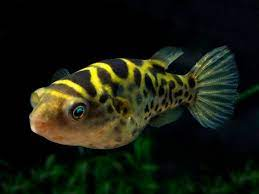
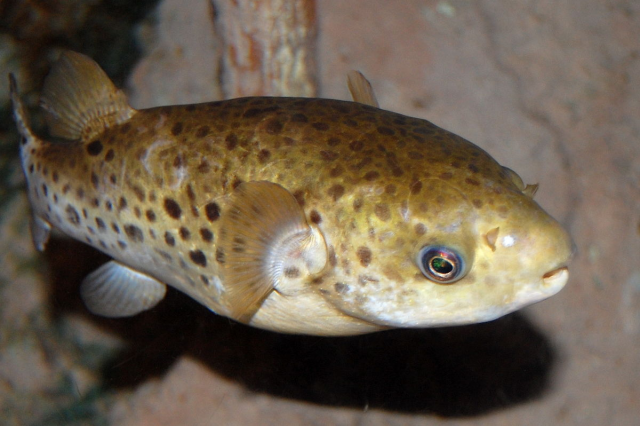
Average size: 5.5"-6.5"
Care: Intermediate
pH: 7.5-9
Salinity: 1.010-1.025
Minimum tank size: 40 gallons/Individual
Temperature: 75-80° F
Diet: Frozen and live foods such as snails, feeder guppies, worms, shrimp, frozen fish, snails, mussels, etc. Like most puffers, it is mandatory to feed this species hard foods in order to trim its teeth.
Natural range: Often found in fresh and brackish water in Asian countries such as India, Bangladesh, Sri Lanka, Myanmar, Thailand, Laos, Cambodia, Vietnam, and Indonesia.
Additional info: Though less common than the former two species, these puffers are still fairly easy to get your hands on.
Saba/Giant Spotted Pufferfish
Dichotomyctere sabahensis
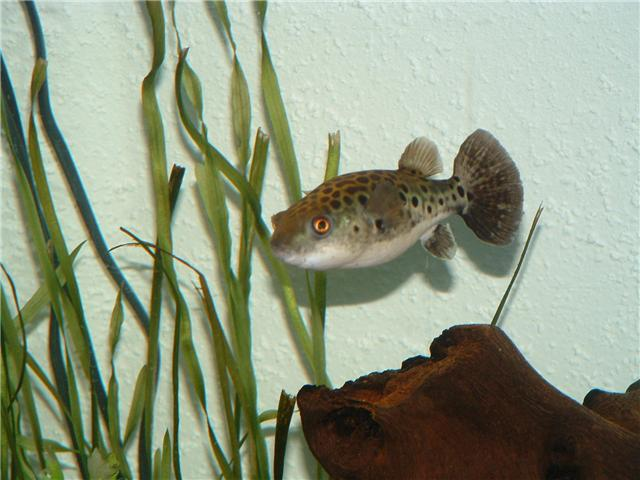
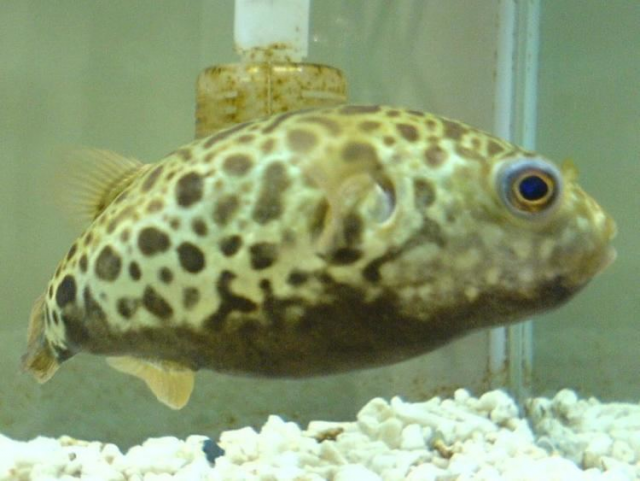
Average size: 5.5"-6.5"
Care: Intermediate
pH: 7.8-8.2
Salinity: 1.005-1.015
Minimum tank size: 40 gallons/Individual
Temperature: 75-80° F
Diet: Frozen and live foods such as snails, feeder guppies, worms, shrimp, frozen fish, snails, mussels, etc. Like most puffers, it is mandatory to feed this species hard foods in order to trim its teeth.
Natural range: Asia [Exact location info insufficient]
Additional info: Very rare species. Somewhat similar to Dichotomyctere nigroviridis in appearance.
Samurai Pufferfish
Dichotomyctere erythrotaenia
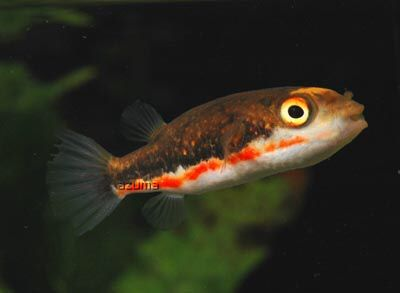
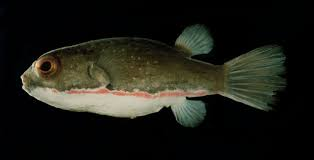
Average size: 3"
Care: Intermediate
pH: 6.0-8.0
Salinity: 1.005-1.010
Minimum tank size: 20 gallons/Individual
Temperature: 75-80° F
Diet: Frozen and live foods such as snails, feeder guppies, worms, shrimp, frozen fish, snails, mussels, etc. Like most puffers, it is mandatory to feed this species hard foods in order to trim its teeth.
Natural range: Found mostly in brackish swamps and rivers around Indonesia and Papa New Guinea.
Additional info: Very rare species, though somewhat more common.
[NO COMMON NAME]
Dichotomyctere kretamensis
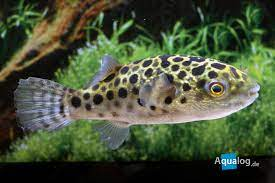
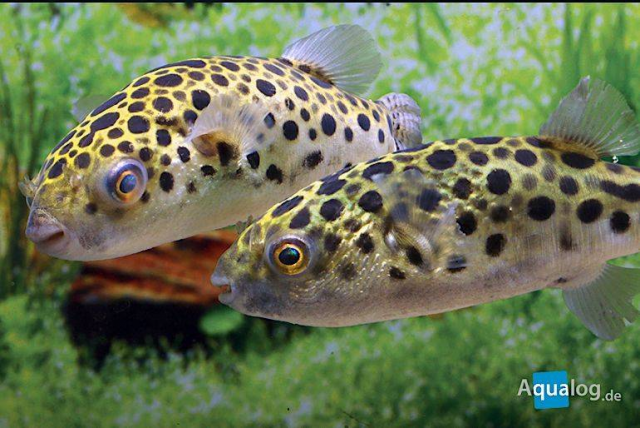
Average size: ~2" [UNCONFIRMED]
Care: Intermediate [PRESUMED]
pH: [DATA INSUFFICIENT]
Salinity: [DATA INSUFFICIENT]
Minimum tank size: [DATA INSUFFICIENT]
Temperature: [DATA INSUFFICIENT]
Diet: Frozen and live foods such as snails, feeder guppies, worms, shrimp, frozen fish, snails, mussels, etc. Like most puffers, it is mandatory to feed this species hard foods in order to trim its teeth.
Natural range: Northern Borneo.
Additional info: Very similar in pattern to Dichotomyctere nigroviridis. The main difference is that they are thinner. These are pretty much the holy grail of Dichotomyctere, and it seems as though next to no one keeps them. If these reports of their size are true, which is not fully confirmed, they would be much like a dwarf GSP. Relatively little is known about this species in terms of scientific research. These fish could easily be confused for nigroviridis or sabahensis, as all three appear rather similar, and are known to inhabit Borneo.
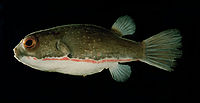
Green-Spotted/Leopard Pufferfish
Dichotomyctere nigroviridis


Average size: 5.5"-6.5"
Care: Intermediate
pH: 7.5-8.5
Salinity: 1.010-1.025
Minimum tank size: 40 gallons/Individual
Temperature: 75-80° F
Diet: Frozen and live foods such as snails, feeder guppies, worms, shrimp, frozen fish, snails, mussels, etc. Like most puffers, it is mandatory to feed this species hard foods in order to trim its teeth.
Natural range: Costal brackish waters, as well as freshwater lakes, streams, and rivers in Asian countries such as India, Sri Lanka, Myanmar, Thailand, Cambodia, Vietnam, Malaysia, Indonesia and the Philippines.
Additional info: Perhaps the most common aquarium pufferfish.
Figure Eight/Eyespot Pufferfish
Dichotomyctere ocellatus


Average size: 3"-4"
Care: Intermediate
pH: 7.5-8.0
Salinity: 1.005-1.008
Minimum tank size: 20 gallons/Individual
Temperature: 75-80° F
Diet: Frozen and live foods such as snails, feeder guppies, worms, shrimp, frozen fish, snails, mussels, etc. Like most puffers, it is mandatory to feed this species hard foods in order to trim its teeth.
Natural range: Freshwater rivers and coasts, also commonly found in brackish water within Asian countries such as Cambodia, Malaysia, and Indonesia.
Additional info: Nicknamed the "eyespot pufferfish" due to their spots, which are believed to serve as "false eyes," a defense mechanism against potential predators.
Ceylon/Green Pufferfish
Dichotomyctere fluviatillis


Average size: 5.5"-6.5"
Care: Intermediate
pH: 7.5-9
Salinity: 1.010-1.025
Minimum tank size: 40 gallons/Individual
Temperature: 75-80° F
Diet: Frozen and live foods such as snails, feeder guppies, worms, shrimp, frozen fish, snails, mussels, etc. Like most puffers, it is mandatory to feed this species hard foods in order to trim its teeth.
Natural range: Often found in fresh and brackish water in Asian countries such as India, Bangladesh, Sri Lanka, Myanmar, Thailand, Laos, Cambodia, Vietnam, and Indonesia.
Additional info: Though less common than the former two species, these puffers are still fairly easy to get your hands on.
Saba/Giant Spotted Pufferfish
Dichotomyctere sabahensis


Average size: 5.5"-6.5"
Care: Intermediate
pH: 7.8-8.2
Salinity: 1.005-1.015
Minimum tank size: 40 gallons/Individual
Temperature: 75-80° F
Diet: Frozen and live foods such as snails, feeder guppies, worms, shrimp, frozen fish, snails, mussels, etc. Like most puffers, it is mandatory to feed this species hard foods in order to trim its teeth.
Natural range: Asia [Exact location info insufficient]
Additional info: Very rare species. Somewhat similar to Dichotomyctere nigroviridis in appearance.
Samurai Pufferfish
Dichotomyctere erythrotaenia


Average size: 3"
Care: Intermediate
pH: 6.0-8.0
Salinity: 1.005-1.010
Minimum tank size: 20 gallons/Individual
Temperature: 75-80° F
Diet: Frozen and live foods such as snails, feeder guppies, worms, shrimp, frozen fish, snails, mussels, etc. Like most puffers, it is mandatory to feed this species hard foods in order to trim its teeth.
Natural range: Found mostly in brackish swamps and rivers around Indonesia and Papa New Guinea.
Additional info: Very rare species, though somewhat more common.
[NO COMMON NAME]
Dichotomyctere kretamensis


Average size: ~2" [UNCONFIRMED]
Care: Intermediate [PRESUMED]
pH: [DATA INSUFFICIENT]
Salinity: [DATA INSUFFICIENT]
Minimum tank size: [DATA INSUFFICIENT]
Temperature: [DATA INSUFFICIENT]
Diet: Frozen and live foods such as snails, feeder guppies, worms, shrimp, frozen fish, snails, mussels, etc. Like most puffers, it is mandatory to feed this species hard foods in order to trim its teeth.
Natural range: Northern Borneo.
Additional info: Very similar in pattern to Dichotomyctere nigroviridis. The main difference is that they are thinner. These are pretty much the holy grail of Dichotomyctere, and it seems as though next to no one keeps them. If these reports of their size are true, which is not fully confirmed, they would be much like a dwarf GSP. Relatively little is known about this species in terms of scientific research. These fish could easily be confused for nigroviridis or sabahensis, as all three appear rather similar, and are known to inhabit Borneo.

Attachments
-
114.8 KB Views: 46
-
122.2 KB Views: 47
-
1.2 MB Views: 51
-
99.3 KB Views: 48
-
70.8 KB Views: 48
-
2 MB Views: 51
-
681.6 KB Views: 50
-
863 KB Views: 50
-
132.1 KB Views: 50
-
123.5 KB Views: 49
-
1 MB Views: 49
-
52.2 KB Views: 50

















